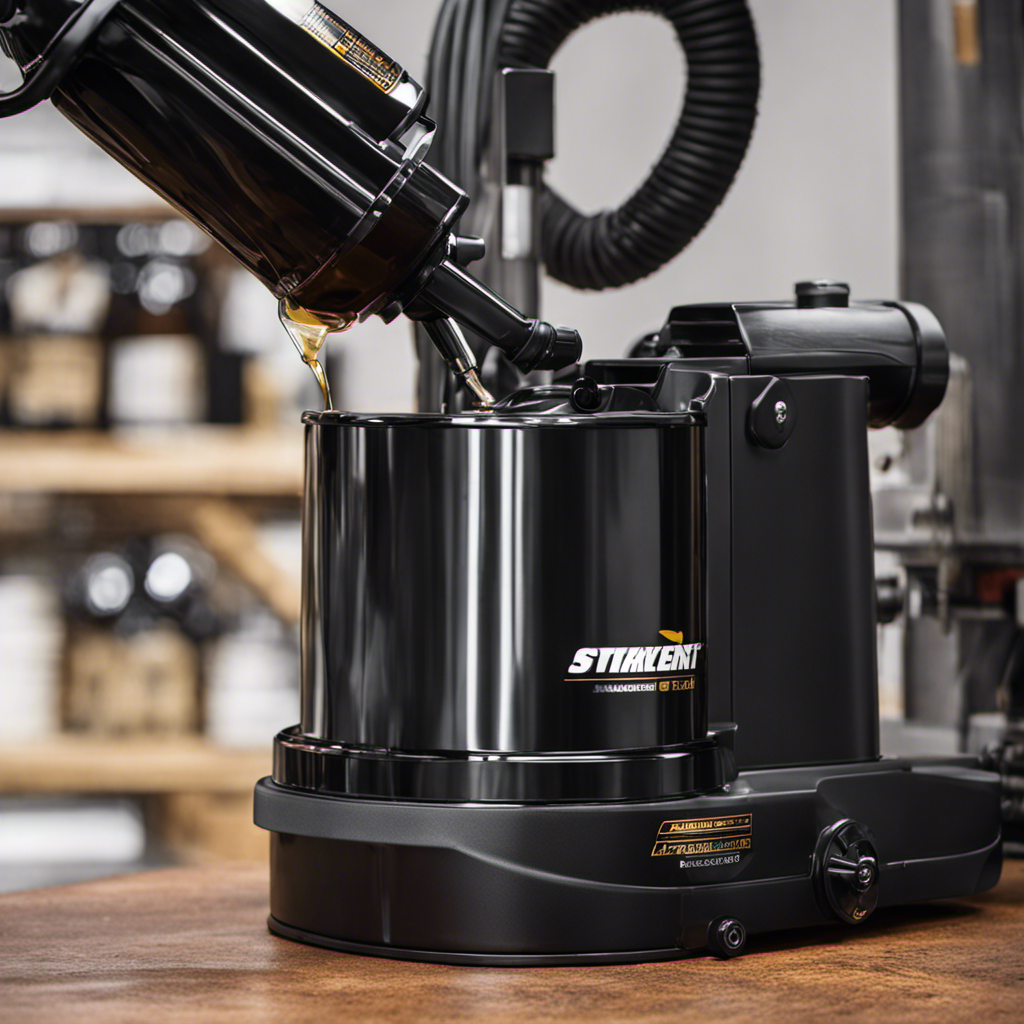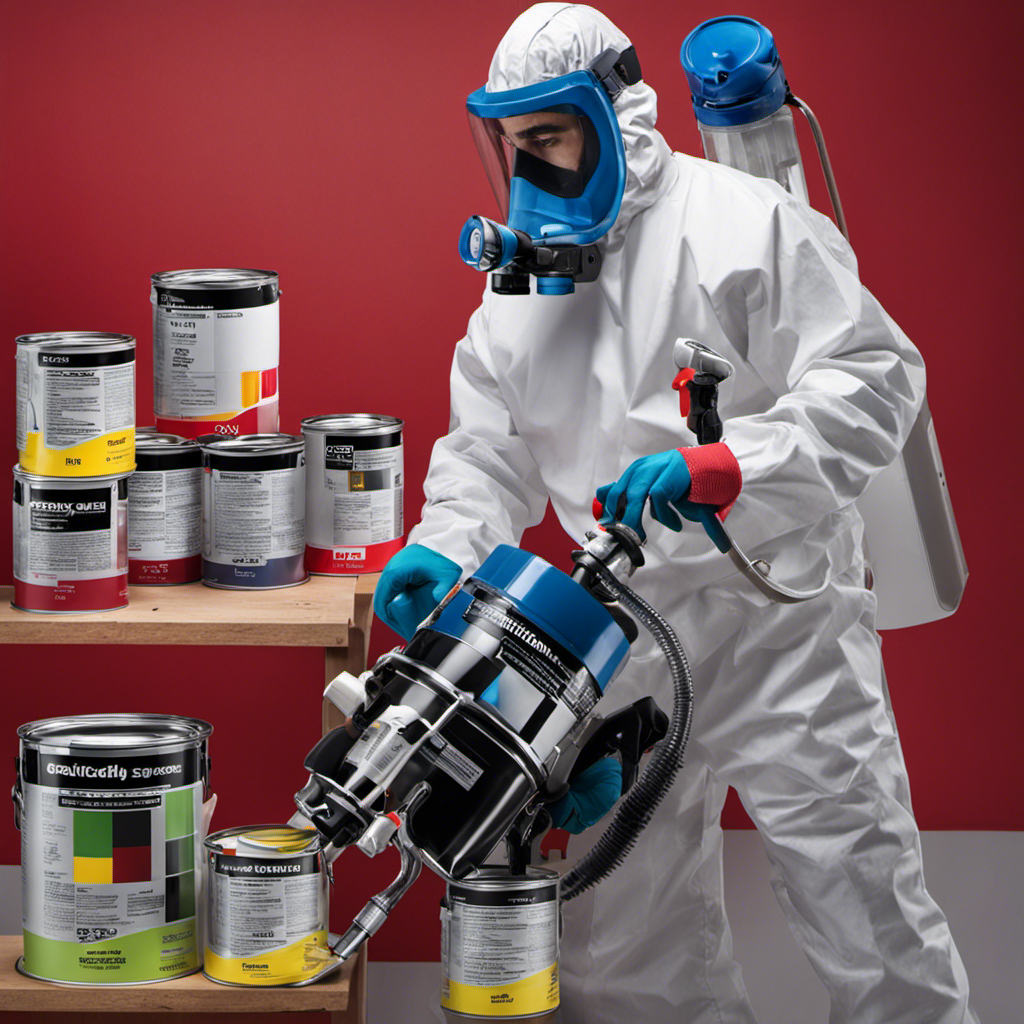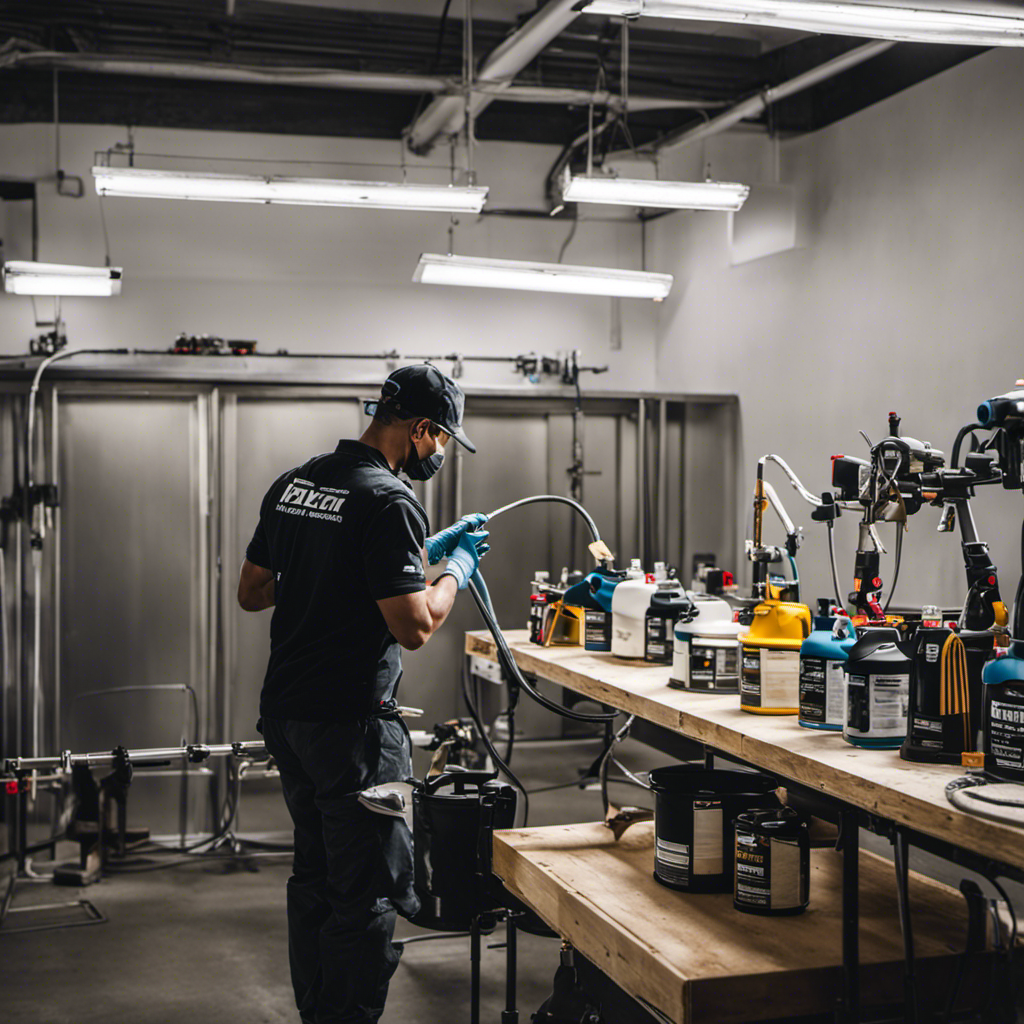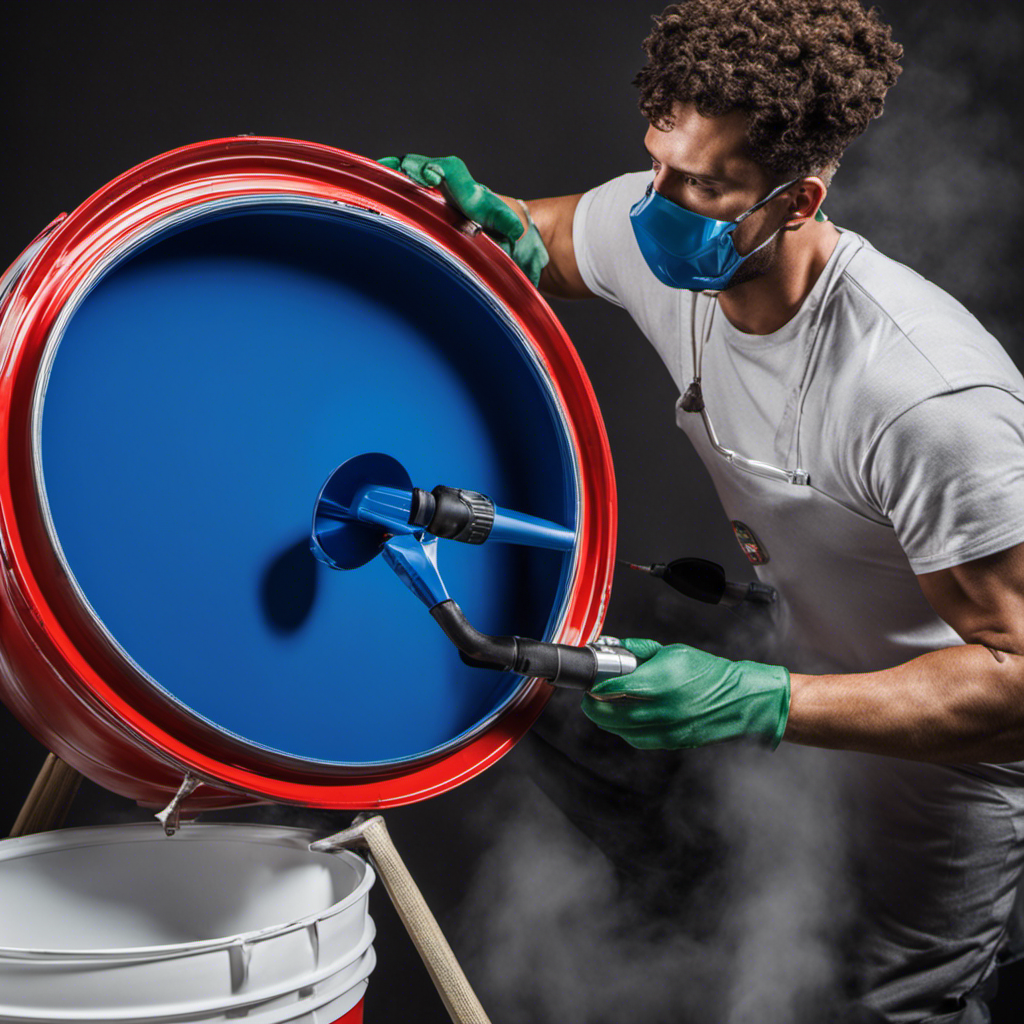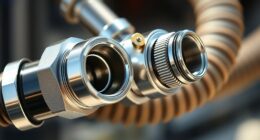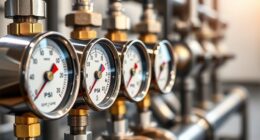When it comes to airless paint sprayers, choosing the correct oil is crucial for optimal performance and durability. Proper maintenance and storage of the oil are essential to prevent equipment malfunctions and avoid unnecessary wear and tear.
The viscosity of the oil greatly influences the spray patterns and coverage, making it vital to select the correct viscosity to avoid clogs and reduced efficiency. By adhering to manufacturers’ guidelines and ensuring regular lubrication, one can optimize their airless paint sprayer’s functioning.
Storing the oil appropriately is also crucial to prevent degradation.
Key Takeaways
- Using the right oil is crucial for optimal functioning and performance of an airless paint sprayer.
- Different types of oil are available that are specifically designed for high pressures and temperatures of airless paint sprayers.
- Viscosity of the oil affects spray patterns and coverage, so understanding viscosity is important for achieving desired results.
- Proper oil maintenance and storage, including regular checks, top-ups, and following manufacturers’ guidelines, ensures effective functioning and longevity of the sprayer.
The Importance of Using the Right Oil
Using the right oil in an airless paint sprayer is crucial for optimal performance and longevity. The role of oil in equipment malfunction cannot be understated. By using low-quality or contaminated oil, users risk clogs and decreased performance.
Regular lubrication with the appropriate oil prevents wear and tear, ensuring the sprayer functions smoothly and efficiently. Neglecting oil maintenance can lead to clogs and inconsistent spray patterns, resulting in subpar paint application.
To avoid these issues, it is important to choose the right oil for airless paint sprayers. Using the wrong oil can lead to clogs and decreased performance. Different types of oil are available that complement airless paint sprayers, providing the necessary lubrication and protection.
Proper Oil Maintenance and Storage
Proper maintenance and storage of the oil is crucial for ensuring optimal functioning of the airless paint sprayer. Preventing oil degradation and extending sprayer longevity are key objectives.
To achieve this, it is important to store oil in a cool and dry place to prevent degradation. Regularly checking and topping up oil levels is essential for optimal performance. Following the manufacturer’s guidelines for oil change intervals is also important.
It is recommended to use high-quality oil specifically designed for airless paint sprayers. This ensures proper lubrication and prevents clogs, resulting in effective functioning.
The Role of Oil in Equipment Malfunction
Improper oil maintenance can lead to equipment malfunction in airless paint sprayers. The role of oil in equipment malfunction is significant as it plays a crucial part in preventing clogs and ensuring optimal performance.
Using the wrong oil or neglecting oil maintenance can result in decreased performance and inconsistent spray patterns. Clogs can occur when the oil fails to lubricate the necessary components, leading to blockages in the sprayer system. This can cause the sprayer to malfunction and result in reduced efficiency.
To avoid these issues, it is important to use the correct oil designed for airless paint sprayers and follow the manufacturer’s recommendations for oil change intervals. Proper oil maintenance is essential for preventing clogs and ensuring consistent, reliable performance.
Regular Lubrication for Preventing Wear and Tear
Regularly lubricating the necessary components of an airless paint sprayer helps prevent wear and tear, ensuring its longevity and optimal performance. Proper oil maintenance is essential for regular maintenance, and choosing the right oil is crucial for the sprayer’s efficiency. When selecting oil for an airless paint sprayer, it is important to consider factors such as viscosity and compatibility. Different types of oil are available that complement airless paint sprayers, but it is crucial to use oil specifically designed for high pressures and temperatures. Using the wrong oil can lead to clogs and decreased performance. Regularly checking and topping up oil levels, following manufacturers’ guidelines for oil change intervals, and using high-quality oil designed for airless paint sprayers are all part of proper oil maintenance and storage. By ensuring proper lubrication and preventing clogs, the airless paint sprayer can function effectively and provide optimal results.
| Point | Details |
|---|---|
| Regular Maintenance | Regularly lubricate necessary components |
| Oil Selection | Choose oil designed for high pressures and temperatures |
| Proper Lubrication | Ensure optimal performance and prevent clogs |
The Impact of Neglecting Oil Maintenance
Neglecting proper oil maintenance and storage can have a detrimental impact on the efficiency and performance of an airless paint sprayer. The consequences of poor oil maintenance can lead to various issues that affect the overall functionality of the equipment.
Here are some key points to consider regarding the impact of oil neglect and the consequences of poor oil maintenance:
- Increased risk of equipment malfunction and breakdown
- Reduced spray quality and inconsistent patterns
- Clogging of the spray gun and nozzle
- Decreased lifespan of the airless paint sprayer
- Inefficient use of paint and increased material waste
To avoid these issues, it is crucial to prioritize oil maintenance. Regularly check and top up oil levels, follow manufacturers’ guidelines for oil change intervals, and use high-quality oil designed specifically for airless paint sprayers.
Proper oil maintenance and storage ensure optimal performance and longevity of your equipment.
Types of Oil Compatible With Airless Paint Sprayers
Different oil types specifically designed for high pressures and temperatures are compatible with airless paint sprayers. These oils are essential for ensuring optimal performance and longevity of the equipment. When it comes to airless paint sprayers, using the wrong oil can lead to clogs and decreased performance. Therefore, it is crucial to choose the right oil that complements the sprayer’s requirements.
Viscosity plays a significant role in sprayer performance, affecting how easily the paint flows and influencing spray patterns and coverage. Different paint formulations have varying viscosities, and temperature also affects viscosity. By understanding viscosity and using the correct oil, users can achieve optimal spray patterns and coverage.
It is important to follow the manufacturer’s recommendations and choose the appropriate oil to prevent clogging and maintain efficiency.
Avoiding Clogs and Decreased Performance
To prevent clogs and maintain optimal performance, users should ensure proper lubrication and follow the manufacturer’s guidelines for oil change intervals.
Neglecting oil maintenance can lead to clogs and decreased performance, resulting in inconsistent spray patterns and reduced efficiency.
By using the correct oil viscosity, users can avoid clogs and improve spray quality. Choosing the right viscosity is crucial, as using the wrong viscosity can lead to clogging and reduced efficiency.
Additionally, high-quality oil with the right additives enhances sprayer longevity and ensures optimal performance.
Proper oil maintenance and storage are essential for preventing clogs and maintaining effective functioning. Regularly checking and topping up oil levels, storing oil in a cool, dry place, and using high-quality oil designed for airless paint sprayers are all important steps in avoiding clogs and improving spray quality.
Choosing the Right Oil for Optimal Performance
Proper maintenance and storage of oil is crucial in order to achieve optimal performance with an airless paint sprayer. Choosing the right oil viscosity and preventing oil degradation are key factors in ensuring the longevity and efficiency of the equipment.
Using the wrong viscosity can lead to clogs and reduced efficiency, resulting in inconsistent spray patterns and decreased coverage. It is important to select oil that matches the manufacturer’s recommendations, as airless paint sprayers require specific oil designed for high pressures and temperatures.
Regular lubrication with the appropriate oil prevents wear and tear, enhancing the sprayer’s performance and longevity. To prevent oil degradation, store the oil in a cool, dry place and follow the manufacturer’s guidelines for oil change intervals.
Understanding Viscosity and Its Impact
In order to fully understand why using the right oil matters for your airless paint sprayer, it is important to delve into the concept of viscosity and its impact on sprayer performance. Viscosity refers to how easily a liquid flows, and it plays a crucial role in determining how well the paint is sprayed.
Different paint formulations have varying viscosities, and understanding this factor is essential for achieving optimal spray patterns and coverage.
Additionally, the consistency of the paint is also affected by viscosity. The right oil can help maintain the desired paint consistency, ensuring smooth and even application. This is where the role of additives in oil performance comes into play.
Additives are specifically designed to enhance the performance of the oil and provide additional benefits such as improved lubrication and protection against wear and tear.
Viscosity and Spray Patterns
Understanding viscosity and its impact on spray patterns is crucial for achieving optimal performance with an airless paint sprayer. Viscosity refers to the thickness or resistance to flow of a liquid. When it comes to paint, viscosity determines how easily it flows through the sprayer and onto the surface being painted.
Proper oil selection plays a critical role in maintaining the desired viscosity for efficient paint flow. Using the right oil ensures that the sprayer operates smoothly and consistently, preventing clogs and disruptions in the spray pattern. In addition, choosing the correct oil enhances the durability of the sprayer by providing adequate lubrication to the internal components.
Temperature and Viscosity Relationship
The temperature of the environment directly affects the viscosity of the paint, which ultimately impacts the spray patterns and coverage achieved by the airless paint sprayer.
When the temperature increases, the viscosity of the paint decreases, resulting in a thinner consistency. This allows the paint to flow more easily through the sprayer, leading to wider spray patterns and better coverage.
On the other hand, when the temperature decreases, the viscosity of the paint increases, causing it to become thicker. This can result in more concentrated spray patterns and potentially uneven coverage.
Therefore, it is important to consider the temperature when using an airless paint sprayer to ensure the paint flows properly and the desired spray coverage is achieved.
Benefits of Using the Correct Oil
Choosing the appropriate oil viscosity ensures optimal performance and longevity of the sprayer. Using high-quality oil provides several benefits for airless paint sprayers.
Firstly, it ensures longevity by reducing wear and tear on the equipment. High-quality oil with the right additives enhances the sprayer’s lifespan and prevents premature breakdown.
Additionally, using the correct oil viscosity improves overall performance. It minimizes the risk of clogs and reduces the chances of reduced efficiency. The sprayer operates smoothly and consistently, resulting in better spray patterns and coverage.
Clogging and Efficiency Issues
Clogs and reduced efficiency can occur when the wrong viscosity is used in an airless paint sprayer. To prevent these issues and maximize efficiency, it is crucial to choose the correct viscosity oil for the sprayer. Here are five important points to consider:
- Using the wrong viscosity oil can lead to clogs, which can disrupt the paint flow and cause uneven spray patterns.
- The right viscosity oil ensures smooth operation and consistent paint application, maximizing the sprayer’s efficiency.
Regular maintenance, including checking and topping up oil levels, helps prevent clogs and ensures optimal performance.
Following the manufacturer’s recommendations for oil change intervals and using high-quality oil designed for airless paint sprayers is essential for preventing clogs.
Proper lubrication with the correct viscosity oil is necessary to prevent wear and tear, prolong the sprayer’s lifespan, and maintain optimal efficiency.
Proper Oil Maintenance and Storage Tips
Proper oil maintenance and storage techniques are essential for preventing oil degradation and ensuring optimal performance of your airless paint sprayer. By following these practices, you can prolong the life of your equipment and avoid costly repairs. Here are some tips for proper oil maintenance and storage:
| Proper Oil Maintenance and Storage Tips |
|---|
| Store oil in a cool and dry place to prevent degradation caused by heat and moisture. |
| Regularly check and top up oil levels to ensure optimal performance. |
| Follow the manufacturer’s guidelines for oil change intervals to maintain the sprayer’s efficiency. |
| Use high-quality oil specifically designed for airless paint sprayers to enhance longevity and performance. |
Frequently Asked Questions
Can I Use Any Type of Oil in My Airless Paint Sprayer?
Using the wrong oil in an airless paint sprayer can damage the machine and affect its performance, so it’s important to use the right type of oil.
Different types of oil are available that complement airless paint sprayers, designed specifically for high pressures and temperatures.
Using the correct oil viscosity is crucial for optimal performance, as using the wrong viscosity can lead to clogging and reduced efficiency.
It’s essential to choose oil that matches the manufacturer’s recommendations to ensure optimal spray patterns and coverage.
How Does Viscosity Affect the Performance of an Airless Paint Sprayer?
Oil viscosity has a significant impact on the performance of an airless paint sprayer. Using the correct viscosity is crucial for optimal functioning.
If the viscosity is too high, the paint may not flow smoothly, resulting in clogs and reduced efficiency.
On the other hand, if the viscosity is too low, the spray pattern may become inconsistent and the coverage may be uneven.
It is essential to choose the right oil viscosity to ensure reliable and effective operation of the airless paint sprayer.
What Happens if I Use the Wrong Viscosity Oil in My Sprayer?
Using the wrong viscosity oil in an airless paint sprayer can have detrimental effects. The potential oil damage includes clogs, reduced efficiency, and increased wear and tear on the equipment.
It is crucial to understand the importance of oil viscosity in maintaining optimal performance. Proper lubrication with the correct viscosity oil ensures smooth flow, consistent spray patterns, and maximum coverage.
Neglecting this aspect can lead to costly repairs and compromised results.
How Often Should I Check and Top up the Oil Levels in My Sprayer?
To properly clean and maintain your airless paint sprayer, it’s important to regularly check and top up the oil levels. This ensures optimal performance and prevents clogs.
Using a high-quality oil designed for airless paint sprayers is crucial for the longevity of your equipment. The benefits of using the right oil include enhanced efficiency, reduced clogging, and increased sprayer lifespan.
Following the manufacturer’s guidelines for oil change intervals and proper lubrication will ensure effective functioning of your sprayer.
Can I Store My Oil in Any Location, or Are There Specific Storage Requirements?
Proper storage conditions for oil are essential to maintain the integrity and performance of your airless paint sprayer. Storing oil in a cool, dry place prevents degradation and ensures its effectiveness when used.
Using the wrong oil can damage your sprayer, causing clogs and reduced efficiency. It’s crucial to follow the manufacturer’s recommendations and use high-quality oil specifically designed for airless paint sprayers.
Conclusion
In conclusion, the choice of oil for an airless paint sprayer is not to be taken lightly. Symbolically, it represents the lifeblood of the equipment, ensuring its optimal performance and longevity.
Neglecting proper oil maintenance and storage would be akin to denying nourishment to the sprayer, leading to equipment malfunction and wear and tear.
By understanding viscosity and the relationship between temperature and oil flow, one can achieve superior spray patterns and coverage.
Ultimately, using the correct oil, combined with regular lubrication and diligent storage, is essential for the effective functioning and maintenance of an airless paint sprayer.
Drenched in creativity and armed with a fountain pen, Isolde weaves words as gracefully as a painter strokes their canvas. A writer for Paint Sprayer Zone, her passion for colors, textures, and spaces finds a harmonious blend with her profound knowledge of painting tools and techniques.
Having grown up in a family of artists, Isolde’s tryst with paints began early. While her relatives expressed themselves on canvas, Isolde found her medium in words. She dedicated herself to chronicling the world of painting, understanding the nuances of each tool, and the artistry behind every spritz of a paint sprayer.
